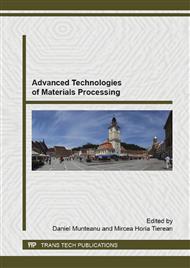p.338
p.347
p.353
p.364
p.372
p.378
p.384
p.390
p.394
Work Conditions Assessment in Welding Environments with Wireless Sensor Networks
Abstract:
This paper presents a composite system implemented with wireless sensor networks for monitoring and controlling the operation in welding environments which raises issues regarding work conditions: air quality (dust particles concentration), climate stress (environmental parameters) and wireless transmissions (tracking, remote operation) with the aim of minimizing work risks and maximizing operator’s safety and health. The wireless interface with the work environment which allows remote operation was developed by the authors using hardware platforms with ZigBee and Wi-Fi transceivers and software based on virtual instrumentation. The results obtained in the welding environment by performing remote measurements based on PM (particulate matter) analysis, sensor data and received signal strength (RSS) have shown that it is possible to detect the areas affected by fumes and with improper climate conditions, to track hazardous objects and to control operations in real-time.
Info:
Periodical:
Pages:
394-400
Citation:
Online since:
October 2015
Authors:
Price:
Сopyright:
© 2015 Trans Tech Publications Ltd. All Rights Reserved
Share:
Citation:


